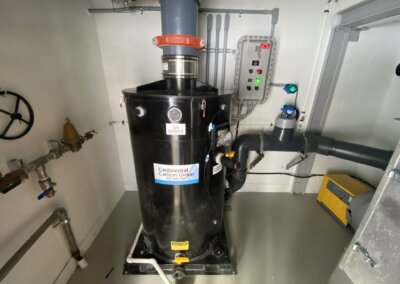About the Project
PBX Engineering was engaged by the Resort Municipality of Whistler (RMOW) to provide an analysis and review of the existing aging and end of life odour control systems servicing three major lift stations across the municipality. These systems prevent the release of H2S gas into the atmosphere which produces a pungent “rotten egg” smell with significant effects on the residents living in proximity.
Each existing station deployed a different style of odour control mitigation including a bio bed, comprised of forced air being pumped through water saturated woodchips; activated carbon scrubbers, with three stages of outdated carbon media scrubbers; and a custom bubbler based liquid media scrubber system, with multiple stages of activated liquid media for removing H2S.
These systems exceeded their design life and become ineffective in removing H2S gas, causing odour complaints from residents in the area, as well as noise complaints due to the forced air ventilation systems requiring maintenance and replacement.
PBX and our design partners developed the design and specifications for a scalable, activated carbon-based scrubber system, that could be deployed at each site and scaled to the specific needs of each station. To accommodate the odour control systems at each station, unique building solutions were required. At the Golden Bear Lift Station, a new Odour Control Kiosk was deployed to house all the odour control equipment. At Crabapple Station, the existing odour control room was enlarged to house the new odour control equipment. At Spruce Grove Station, the largest of the three stations, a new building was constructed to accommodate the equipment.
While the technology deployed at each station was similar, the type of building construction presented unique challenges at each one.
Approach
Using proven design methods and investigative techniques and testing, PBX and our consulting partners evaluated the odour control systems at 3 Whistler Lift Stations and concluded they had reached end of life and needed replacing.
PBX engaged in their design, ensuring collaboration with key municipal resources within the various departments. PBX highly values client engagement during design to ensure all requirements are met and the systems’ maintenance teams are heard with their preferences incorporated into the proposed solutions.
Following an iterative and productive design process to ensure the best final solution, PBX prepared and delivered a tender package for the municipality to engage contractors. Weeks after tender was awarded, COVID-19 broke and caused widespread disruption.
PBX supported the municipality and contractor in the procurement of appropriate equipment throughout this period, and construction was able to proceed 6 months following award of contract. Constructing through subsequent lockdowns and difficult conditions imposed by health mandates were managed throughout the project and the station was ready for commissioning on schedule, based on the equipment delivery.
PBX provided valuable services to maintain schedules for funding related to this project throughout a difficult period in the construction industry. The contracting team was supportive throughout and appreciated being able to keep workers on their tools through this period as well.
Results
At the start of the project, H2S output levels were at an odorous 20 parts per million (ppm); after our new systems were installed and activated, the output levels dropped to below the detectable threshold of 0.1 ppm – a significant decrease and improvement for the many residents living in the vicinity. With the careful planning that went into the systems integrations, there was also no unplanned downtime, resulting in an effective and efficient project delivery.
Service(s) Provided
Prime consultant
Project Team (Consultants)
Water Street Engineering
Gygax Engineers and Associates
Project Team (Contractors)
Drake Excavating
Go back to projects in
View other projects from
Stay in touch with us
Subscribe to our mailing list!
Organization
Connect





